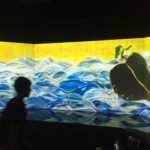Rather than rushing out with a perspective early on in the pandemic that I’d later regret, I decided to wait and see how things shaped up. Finally, in late October 2020, I had a chance to reflect in Nautilus (article) on the year’s events, and the spatial shifts in and around cities already in play and those to come.
As the pandemic drama crawls toward denouement in the coming year—whether by deployment of an effective vaccine or a natural decline in transmission—we’re left to wonder what, if anything, of this ad hoc dispersal will persist? Will the digital diaspora put down roots or return to the city? Will stores reopen and if so, will people go out to shop again?
The essay is nominally about automated vehicles, but really centers on setting up a straw man concept I call flexible density, an urbanism predicated on frequent, sudden shutdowns and various overlapping forms of technologically-enabled quarantine and dispersal:
Flexible density will be a shocking proposition for city builders and their advisors. For centuries, they’ve responded to pandemics by hardwiring social distancing into the urban fabric. After surviving the arrival of bubonic plague in Milan in 1485, Leonardo da Vinci sketched a series of unrealized designs for the city that included broader spaces for circulation. Four hundred years later, the early 20th-century modernists obsessed over windows and plazas in an effort to bring more sunlight and fresh air into buildings and neighborhoods. Because of their rigidity, however, these schemes didn’t weather well. The permanent separation they baked in was too high a cost for city dwellers to bear. Over time, many drifted back to the old packed-in places that pre-dated the new ones. Those classic, tight-knit neighborhoods are still the places people love most. And they are our best models for sustainable, human-centered urban design. But they are not impervious to the shocks ahead.
Flexible density can help us navigate these tensions. It recognizes that dispersal is a strategy for resilience, but need not be permanent, or incongruent with the virtues of compact development. It recognizes the existential nature of the threats that cities face in the 21st century, and that the static way we’ve been thinking about resilience to date may not be enough. Yet it offers hope too. It shows that even as the risks we face grow, so too do our capabilities. And it puts technology in its place, as a tool for boosting those capabilities. Flexible density highlights the potential for advances in automated mobility to unlock new design possibilities for buildings, infrastructure, and services—while not wholeheartedly re-organizing the future around their demands. There is much to be worked out about the details of how flexible density will work in the real world. But it is clear that we can and should challenge ourselves to peek over the horizon and imagine a tomorrow where flexible density is part of how we make ourselves at home on the other side of this very weird and unsettling present.
“The Self-Driving Car Is A Red Herring“, by Anthony Townsend, Nautilus, October 21, 2020





